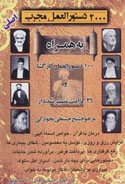What does “Shi‘ah” mean?
Question
What does “Shi‘ah” mean?
Answer
In Arabic “Shi‘ah” literally means “follower”. The Glorious Qur’an states:
وَإِنَّ مِن شِيعَتِهِ لإِبْرَاهِيمَ
“Indeed Abraham was among his followers {Shi‘ah}.”[1]
But the Muslims use the word “Shi‘ah” to mean the group of people who believe that prior to his demise, the Prophet (S) had designated his successor and the caliph of the Muslims in numerous occasions such as the day known as “Ghadir” on Dhu’l-Hijjah 18, 10 AH and in a mammoth assembly (of Muslims) he (S) appointed him as the political, intellectual and religious authority after him (S).
To elucidate, after the Holy Prophet (S), the Muhajirun[2] and the Ansar[3] were divided into two groups:
1.A group believed that the Prophet of Allah (S) did not ignore the question of caliphate and he designated ‘Ali ibn Abi Talib (‘a)—the first person who believed in him (S)—as his successor.
This group is composed of Muhajirun and Ansar with all the leading figures of the Bani Hashim[4] and a number of great Companions {sahabah}[5] such as Salman al-Farsi, Abu Dharr, Miqdad, Khabbab ibn Art, and the like. They remained firm in their belief and were called the “Shi‘ah of Ali (a)".
Of course, this appellation has been given by the Holy Prophet (S) himself during his lifetime to the followers of the Commander of the Faithful (‘a). While pointing to ‘Ali ibn Abi Talib (‘a), he said:
"والّذي نفسي بيده إنّ هذا و شيعته لهم الفائزون يوم القيامة"
“By Him in Whose hand my life is, verily this man (‘Ali) and his Shi‘ah shall be the triumphant on the Day of Resurrection.”[6]
Therefore, “Shi‘ah” means a group of Muslims of the early period of Islam who, on account of the belief that wilayah {guardianship}[7] is based on revelation {tansisi}, are given this appellation, and this group has remained faithful to the Prophet’s Household {Ahl al-Bayt} (‘a) until today.
From this, we realize the station and position of the Shi‘ah, and in this way the groundless statement of some ignorant or spiteful concocters who claim that Shi‘ism is a product of the later periods, becomes clear. For further information on the history of the Shi‘ah, one may refer to such books as Asl ash-Shi‘ah wa Usuluha, Al-Muraja‘at, and A‘yan ash-Shi‘ah.
2. Another group believed that the station of caliphate is an electoral position. As such, they paid allegiance to Abubakr and later on, they were known as the “Ahl as-Sunnah” or “Sunni”.
The result was that notwithstanding the fact that these two Muslim sects have so many common views about the roots of religion, they have different attitudes toward the question of caliphate and succession to the Prophet. The members of each of the two groups were from among the Muhajirun and Ansar.
[1]Surah as-Saffat 37:83.
[2]Muhajirun: a title given to the Muslims of Mecca who accompanied the Prophet (S) in his hijrah (migration) to Medina. {Trans}.
[3]Ansar: a title given to the Muslims of Medina who received the Prophet (S) and the Muslims of Mecca who migrated (hijrah) to Medina. {Trans}.
[4]Bani Hashim: a clan in Mecca to which the Prophet and his descendants belong. {Trans}.
[5]Companions {sahabah}: it refers to the Companions of the Prophet (S). In earlier times, the term was given only to his close friends who had close contact with him. Later, the term was extended to include the believers who had seen him, eventhough it was for a brief moment or at an early age. {Trans}.
[6]Jalal ad-Din as-Suyuti, Ad-Durr al-Manthur, vol. 6, on the commentary of Surah al-Bayyinah 98:7:
إنَّ الَّذِينَ ءامَنُوا وَعَمِلُوا الصّالِحَاتِ أُوْلئِكَ هُمْ خَيْرُ الْبَرِيَّةِ
“Indeed those who have faith and do righteous deeds—it is they who are the best of creatures.”
[7]For further information about the idea of guardianship {wilayah} and the guardian {wali}, see Murtada Mutahhari, Wilayah: The Station of the Master, trans. Yahya Cooper (Tehran: World Organization for Islamic Services, 1982). {Trans}.
مطالب مشابه با این موضوع:
وبگــــــــــردی طلبۀ پاسخگو
- فایل اعمال و رفتار های خلاف قانون جناب آقای حسن روحانی
- در کنج خانه طلبهها چه میگذرد؟
- سکوت چند ساله مسئولان حوزه در قبال حملات وحشیانه به طلاب!
- می گویند که مملکت مملکت آخوندهاست!!
- یک ماجرای تلخ که خانم ها با تأمل بیشتر بخونند
- جریان های تکفیری موجود در عراق و نحوه شکل گیری آنها
- سیر تکاملی تفکر سلفیه چگونه بوده است؟
- بداء در قرآن و حدیث چگونه مطرح شده است؟
- پیامبر (ص) با مخالفین خود چگونه بر خورد می کرد؟
- سبک زندگی حضرت زهرا سلام الله علیها
- ملاک کرامت و شرافت افراد، انسانیت است یا جنسیت؟
- رنگ و پوشش های رنگی در اسلام
- حجاب، زنان را افسرده میکند و مانع پیشرفت اجتماعی آنهاست!!!
- علوم لدنی معصومین
- مگر ولی فقیه معصوم است که ولایت مطلقه دارد؟
- اگر خدا ازعاقبت ما اطلاع دارد قیامت برای چیست؟
- آیا بجای نماز خوندن، پیانو یا سه تار بزنم؟
- چرا مراسم عزاداري امام حسين(ع) پيش از شهادت ايشان صورت ميگيرد؟
- چرا امام حسين(ع) در كربلا براي رفع تشنگي از خداوند طلب باران نكرد؟
دانــــــلود های مفیـــــــــــــــــــد
- دانلود پاورپوینت شناخت وهابیت و صهیونیسم و ارتباط با همدیگر
- دانلود دو پاورپوینت اجرای عید غدیر خم
- دانلود پاورپوینت احتجاج اميرمؤمنان (ع) به غدير
- پژوهشی در کلام و پیام مقام معظم رهبری پیرامون ماه رمضان
- خطبه شعبانیه و خطبه امیرالمومنین(علیه السلام) پیرامون روزه و ماه رمضان
- دانلود پاورپوینت و pdf تفاوت های زن و مرد
- دانلود جزوه ساعات سعد و نحس(زمان نوشتن دعا)
- تقویم مذهبی شمیم یار 96 مخصوص کامپیوتر
- دانلود نرم افزار «شیعه شناسی»
- دانلود پاورپوینت ساختار خانواده و مسایل آن
- دانلود کتاب دایره المعارف جنسی
- دانلود نکات جذاب دوران عقد
- دانلود کتاب درمان سرد مزاجی و بی میلی جنسی بانوان
- دانلود کتاب حسادت کودکان
- دانلود کتاب درمان خستگی وناتوانی جنسی
- دانلود پاور پوینت اسیب های ازدواج وخانواده
- دانلود پاورپوینت هشت گام برای تحقق رویا به واقعیت
- دانلود پاورپوینت تقویت اراده
- دانلود پاورپوینت موفقیت وروشهای رسیدن به ان
- دانلود پاورپوینت هنر رفتار با افراد دشوار
- دانلود پاورپوینت جملات جالب وجذاب روحیه بخش بزرگان
- دانلود پاورپوینت راههای مقابله ودرمان استرس
- دانلود پاورپوینت نیازهای اساسی کودکان
منبــــرهای مکــــــــــــــــــتوب
- منبر مکتوب: روز عرفه و فرصت ها
- منبر مکتوب: سبک زندگی امام باقر علیه السلام
- منبر مکتوب: سه نیاز مومن (امام جواد علیه السلام)
- سخنرانی سلسله ای و چند جلسه ای مناسبت ماه رمضان
- دانلود 30 جلسه سخنرانی ماه مبارک با موضوع تنها مسیر
- موضوعات پیشنهادی سخنرانی برای محرم
- فضائل حضرت قمر بنی هاشم علیه السلام
- برکات وجود ابا عبدالله علیه السلام بر عالم
- بررسی بُعد اخلاقی،عبادی و عرفانی عاشورا
- آخرين وصيت امام حسين عليه السلام
- اولین علت رویاروی در کربلا؛ دوری از یاد خدا
- هميشه حزن؟ شادي چرا نه؟ - شب دهم محرم
- چرا نفرين ؟ - شب نهم محرم
- نماز ظهر عاشورا - شب هشتم محرم
- فلسفه عزاداری - شب هفتم محرم
- دفاع از دین - شب ششم محرم
- فلسفه حضور خانواده سيد الشهداء - شب پنجم محرم
- علم امام علیه السلام به شهادت - شب چهارم محرم
- فقدان شرایط امر به معروف و نهی از منکر- شب سوم محرم
مناظرات طلبه پاسخگو
جدیدترین های زبان انگلیسی
- Islam and Its Social System
- Duties of Man Towards the People
- Islam Various Systems
- Attributes of The Real Follower of Imams in Their Teachings
- Who is a Real Shia Muslim?
- RIGHTS OF SCHOLARS
- Islam Attacks Slavery 1
- The Advantages of Religion 2
- The Clearest Reason for Free Will
- Sheikh Zakzaky to be released on bail
- Brief History of Religions
- Is It Necessary For Man To Follow A Religion?
- The Advantages of Religion 1
- Who Is Almighty Allah?
- What are the differences between Shia and Sunni Muslims؟
- The Rights Islam Offers to Women
- How I find that Islam does not Oppress Women?
- URGENT MEDICAL TREATMENT FOR SHEIKH ZAKZAKY
- The motto of this year’s book fair is “Reading Is Ability”.
- Fundamental principles of Islam
بیشترین دانلود ها
- دانلود صوتي تکنیک های نزدیکی زن و شوهر (108047)
- دانلود رایگان کتاب خواص سوره های قرآن (54748)
- دانلود پاورپوینت بسیار مفید مهارت های زندگی (37413)
- دانلود پاورپوینت و pdf تفاوت های زن و مرد (33765)
- دانلود كتاب مسائل جنسي و زناشوئي در احاديث (33747)
- دانلود کتاب دایره المعارف جنسی (31789)
- دانلود پاورپوینت های آموزش پیش از ازدواج (30491)
- دانلود بسیار مفید پاورپوینت آئین همسرداری (29854)
- دانلود پاورپوینت آموزشی بررسی رابطه دختر و پسر (29506)
- دانلود 110جلد کتاب بحارالانوار علامه مجلسی ره (29455)
- دانلود كتاب دختران خوب به آسمان می روند دختران بد به همه جا (28448)
- دانلود کتاب آموزش جنسی آقایان (28239)
- دانلود كتاب فرق و مذاهب كلامي استاد رباني گلپايگاني (28189)
- دانلود کتاب درمان سرد مزاجی و بی میلی جنسی بانوان (27989)
- دانلود نکات جذاب دوران عقد (27526)
- دانلود نرم افزار «شیعه شناسی» (25826)
- دانلود کتاب درمان خستگی وناتوانی جنسی (25094)
- دانلود پاورپوینت تقویت اراده (23575)
جدیدترین مطالب سایت
- پاسخ به شبهات ولایت (4647) بازدید
- پاسخ به شبهات ولایت (4441) بازدید
- اذان در جامعه اسلامی نماد چیست ؟ و چرا فقط سه بار در روز تکرار می شود ؟ (3875) بازدید
- باتوجه به عادل بودن خداوند چرا بعضی از انسانها را ناقص الخلقه آفریده است ؟ (3950) بازدید
- ویژگی خاص قرآن چیست که کسی نمی تواند مانند آن را بیاورد ؟ (4168) بازدید
- با توجه به ترک خود ارضایی عوارض آن هنوز در من هست چگونه آن را برطرف کنم ؟ (5568) بازدید
- آیا بدن اخروی مانند بدن مادی است ؟چهره ی واقعی انسان در قیامت چگونه است ؟ (4964) بازدید
- آیا ادعای ملاقات امام زمان (عج) از جانب برخی افراد صحت دارد ؟ (4465) بازدید
- چرا به اصول و قواعد دین اسلام توجه نمی شود و پذیرش آن از سوی پیروان ادیان دیگر سخت است ؟ (4836) بازدید
- فلسفه وجود لباس روحانیت در عصر حاضر چیست ؟ (3514) بازدید
- آیا وظیفه یک روحانی تنها راهنمایی مردم و فعالیت و تدریس در حوزه هاست ؟ (2926) بازدید
- آیا نظریه تناسخ از دیدگاه اسلام پذیرفته شده است ؟ (5183) بازدید
- آیا توصیف بهشت و جهنم در قرآن تمثیل هایی برای درک بهتر آن جهان است ؟ (4799) بازدید
- با توجه به اینکه اسلام کاملترین دین هست چرا ما نسبت به کشور های غیر مسلمان عقب مانده تر هستیم ؟ (6686) بازدید
- نقش امام و رهبر در جامعه اسلامی چیست ؟ و اگر نباشد چه اتفاقی می افتد ؟ (4507) بازدید
پربازدیدترین های سایت
- زنی هستم که میخواهم به شوهرم خیانت کنم!!! (605261)
- آيا زن شوهر دار بخاطر رفع نیاز جنسی اش ميتواند صیغه شود؟ (500960)
- دوست دخترم حامله شده چکار کنم؟ (398564)
- میل جنسی زیادی دارم و به شدت داره منو عذاب می ده (340463)
- دیدن فیلم های مبتذل زن و شوهر برای تحریک شدن جنسی (217794)
- چگونه همسرمان را آماده آميزش جنسي كنم؟+18 (213110)
- حکم شرعی نزدیکی از پشت! (208008)
- خانم هایی که می خواهند طلبه شوند بخوانند!!! (205447)
- زنم رابطه جنسی برقرار نمیکند!!! (199649)
- از تجربه های تلخ و تکان دهنده دختران بخوانید شاید... (172377)
- گناه با محارم خود داشتم! (146282)
- رابطه جنسی دهانی حكم چيست؟ (130701)
- محرمات و مکروهات و مستحبات حائض+حکم ورد به امکان مقدسه (129477)
- به رابطه خانمم با خواهر زاده اش مشکوکم؟ (123100)
- سفارش اسلام در مورد آمیزش صحیح چیست؟ (99031)
- نام كتاب حضرت نوح و حضرت ابراهیم؟ (97022)
- با زنان چشم سبز ازدواج نکنیم؟ (94724)


















